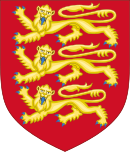| Counties of England | |||||
|---|---|---|---|---|---|
| |||||
| |||||
| Category | Counties | ||||
| Location | England | ||||
| Found in | Regions of England | ||||
| Created |
| ||||
| Possible types |
| ||||
| This article is part of a series within the Politics of the United Kingdom on the |
 |
|---|
The counties of England are a type of subdivision of England. Counties have been used as administrative areas in England since Anglo-Saxon times. There are three definitions of county in England: the 48 ceremonial counties used for the purposes of lieutenancy; the 84 metropolitan and non-metropolitan counties for local government;[a] and the 39 historic counties which were used for administration until 1974.[1]
The historic counties of England were mostly formed as shires or divisions of the earlier kingdoms, which gradually united by the 10th century to become England. The counties were initially used primarily for the administration of justice, overseen by a sheriff. They subsequently gained other roles, notably serving as constituencies and as areas for organising the militia, which was the responsibility of the lord-lieutenant. The county magistrates also gradually took on some administrative functions.
Elected county councils were created in 1889, taking over the administrative functions of the magistrates. The functions and territories of the counties have evolved since then, with significant amendments on several occasions, notably in 1889, 1965 and 1974.
Following the 1974 reforms, England (outside Greater London and the Isles of Scilly) had a two-tier structure of upper-tier county councils and lower-tier district councils, with each county being designated as either a metropolitan county or a non-metropolitan county. From 1995 onwards numerous unitary authorities have been established in the non-metropolitan counties, usually by creating a non-metropolitan county containing a single district and having one council perform both county and district functions. Since 1996 there have been two legal definitions of county: the counties as defined in local government legislation, and the counties for the purposes of lieutenancy (the latter being informally known as ceremonial counties).
The local government counties today cover England except for Greater London and the Isles of Scilly. There are six metropolitan counties and 78 non-metropolitan counties. Of the non-metropolitan counties, 21 are governed in a two-tier arrangement with an upper-tier county council and a number of lower-tier district councils, 56 are governed by a unitary authority performing both county and district functions, and one (Berkshire) is governed by six unitary authorities whilst remaining legally one county.
For the purposes of lieutenancy England (including Greater London and the Isles of Scilly) is divided into 48 counties, which are defined as groups of one or more local government counties.[b]
Counties are also frequently used for non-administrative purposes, including culture, tourism and sport, with many organisations, clubs and leagues being organised on a county basis. For the purpose of sorting and delivering mail, England was divided into postal counties until 1996; they were then abandoned by Royal Mail in favour of postcodes.
Cite error: There are <ref group=lower-alpha> tags or {{efn}} templates on this page, but the references will not show without a {{reflist|group=lower-alpha}} template or {{notelist}} template (see the help page).
- ^ "A Beginners Guide to UK Geography (2023)". Open Geography Portal. Office for National Statistics. 24 August 2023. Retrieved 9 December 2023.


